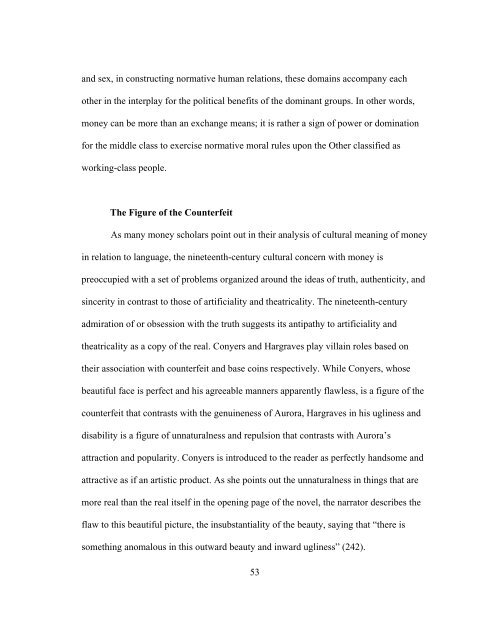CENTURY LITERATURE A Dissertation by JUNG SUN ... - Repository
CENTURY LITERATURE A Dissertation by JUNG SUN ... - Repository
CENTURY LITERATURE A Dissertation by JUNG SUN ... - Repository
Create successful ePaper yourself
Turn your PDF publications into a flip-book with our unique Google optimized e-Paper software.
and sex, in constructing normative human relations, these domains accompany each<br />
other in the interplay for the political benefits of the dominant groups. In other words,<br />
money can be more than an exchange means; it is rather a sign of power or domination<br />
for the middle class to exercise normative moral rules upon the Other classified as<br />
working-class people.<br />
The Figure of the Counterfeit<br />
As many money scholars point out in their analysis of cultural meaning of money<br />
in relation to language, the nineteenth-century cultural concern with money is<br />
preoccupied with a set of problems organized around the ideas of truth, authenticity, and<br />
sincerity in contrast to those of artificiality and theatricality. The nineteenth-century<br />
admiration of or obsession with the truth suggests its antipathy to artificiality and<br />
theatricality as a copy of the real. Conyers and Hargraves play villain roles based on<br />
their association with counterfeit and base coins respectively. While Conyers, whose<br />
beautiful face is perfect and his agreeable manners apparently flawless, is a figure of the<br />
counterfeit that contrasts with the genuineness of Aurora, Hargraves in his ugliness and<br />
disability is a figure of unnaturalness and repulsion that contrasts with Aurora’s<br />
attraction and popularity. Conyers is introduced to the reader as perfectly handsome and<br />
attractive as if an artistic product. As she points out the unnaturalness in things that are<br />
more real than the real itself in the opening page of the novel, the narrator describes the<br />
flaw to this beautiful picture, the insubstantiality of the beauty, saying that “there is<br />
something anomalous in this outward beauty and inward ugliness” (242).<br />
53
















